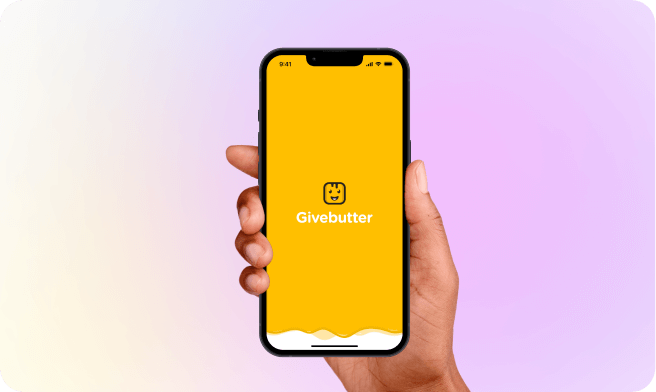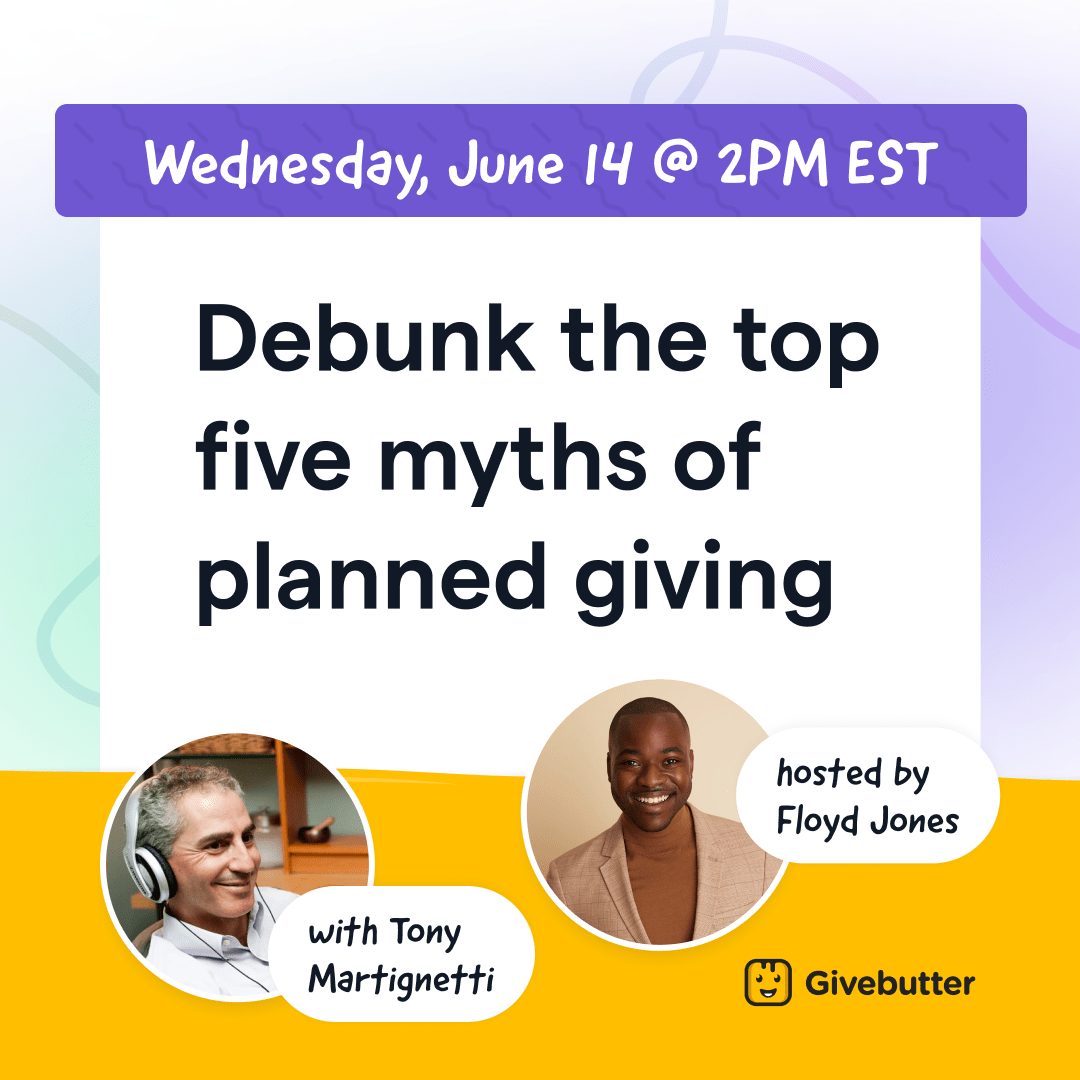Table of contents
Table of contents
What is moves management?
Moves management is a 5-step process of transforming people who are brand new to your organization into champions for your cause. The term "moves management" was developed by a development officer at an Ivy League university who based the process on this simple idea:
Change people’s attitudes so they want to give.
You can think of "moves" as the steps in a ladder of engagement you set up for your donors to climb. This ladder takes them through learning about your work, making their first contribution, becoming a recurring donor, and even giving in higher amounts. The "management" piece is the intentional way YOU nurture this relationship and guide them through each step, making it as seamless a process as possible.
Why is moves management so important?
Moves management helps you increase recurring donations, which are the key to financial sustainability for many nonprofits. Unfortunately, recurring donors don't just sprout up out of thin air. Even the donors who stumble upon your organization "by chance" were introduced to your mission somehow—a friend's Facebook post, an article they read, or an event they attended as a plus one.
Moves management empowers you to intentionally guide prospective donors from a general awareness of your organization to a loyal investment in your mission.
Moves management template
Moves management has five core stages around which your organization can make a plan. This plan, combined with the right fundraising tools, can help you increase successful conversions at all giving levels. You can visualize your moves management template as a ladder, funnel, lifecycle, or bullseye.

The following template can help you visualize and remember each stage of the moves management cycle. We'll break down these stages in the following sections so you know what steps, tools, and metrics are involved in each.

5 core stages of the moves management cycle
1. Awareness: Make your mark 💥
The first step is to catch new donors' eyes with compelling stories of your organization's history, mission, impact, and vision. Remember, there are 1.6 million tax-exempt nonprofits in the US. Show donors why they should give to your organization.
This is NOT the time to make "the ask." Instead, focus on engaging, educating, and providing great experiences, so people have an opportunity to get to know your organization.
💃 Moves
Host engaging events: Have dedicated staff or volunteers at each event whose only job is to seek out and welcome newcomers through casual conversations or at a designated information table. Make your organization a place where people feel welcomed and want to return to (Giving out free branded swag never hurt 👀).
Tell your story: It's critical to share the individual stories, precise needs, and direct impact your organization is having through your interactions with potential donors. This includes 1:1 interactions, formal remarks made at events, and all of your print and online materials. It's stories, not charts or statistics (though it's great to include numbers and other visual storytelling elements), that people will tell their friends about. Stories are also what they'll remember when it's time to give.
🧰 Tools
Social media: Showcase how you're making change in your community through social media. With user-friendly design tools like Canva, you can make your posts stand out with photos and bold, colorful graphics. Feature testimonials from those impacted by your organization, and consider paying to give posts a boost to make the most of this tool.
Video: Nonprofit videos are one of the most effective tools for communicating with potential donors. It doesn't have to be complicated. You can start by creating a reel of impact stories from your founders, volunteers, and the people most impacted by your work.
Landing page: To build relationships with potential supporters, you need a website—or, at the very least, a branded donation page—that explains who you are, what you do, and how you support your community. Add videos, campaign updates, and an FAQ section to help potential supporters learn more.
Email: A thoughtful email automation strategy can help you scale your awareness plan. If nothing else, add an email signup form to your website or donation page that automatically sends subscribers a welcome email series to learn more about your organization.
🧮 Metrics
Nonprofits in the awareness stage should create goals for and track how many new signups or registrations (not new donations—that will come later) they bring in from in-person events, email signups, and online registrations. You will only get a fraction of your supporter base to donate, so make that base is big enough to count. Social media metrics at this stage can also help you understand how many people you're reaching on various online platforms and what content is compelling them to click to learn more about your organization.
💪 Bottom line
The awareness stage is a critical starting point for attracting supporters, regardless of your organization's size or how much you hope to raise from individual donations. While it can feel like it's taking up a lot of the hours in your day, many tools and strategies can help you streamline the process without watering it down.
2. Identification: Understand your donors 🕵️♀️
Just as potential donors can't give to your organization if they don't know you exist, you won't bring in any new major gifts without figuring out who in your larger network is in a position to give and at what level.
Use the identification stage as a time to take stock of your donor base and who you might prioritize to take to the next level. Consider who you would want to ask to become a recurring donor or increase their current giving—even if it's only $10 more monthly.
💃 Moves
Audit your current donor list: How many people are giving in your highest range of donations? The middle range? Who could be giving more? Who should you remind to give again? Who's giving monthly? Who should be? The more you segment your list and tailor a moves management cycle to a particular subset of your donors, the more successful you will be in making those conversions.
Make your new donor wishlist: With the help of your staff and board, map out your larger network and make a list of new people who you can ask to make a gift to your organization. Research your prospects and ask yourself: What is their giving capacity? Where do they already make donations? What are their interests and values?
🧰 Tools
CRM: "Constituent relationship management," or CRM (a fancy term for a donor database), is an invaluable tool for organizing information about your current and potential donors. With Givebutter's free nonprofit CRM, you can segment and filter your list any way you'd like. A CRM makes it easy to track a donor's interactions with your organization, including every gift, email, text message, event registration, or volunteer history.
Wealth screening sites: If higher-level prospect research is right for your organization, sites like Wealth Engine can help you do a lot of digging. Wealth screen sites can even connect to your CRM, as with Givebutter's DonorSearch integration.
Search engines: Never underestimate the power of "Googling" a potential donor and reviewing all the (ethical) open-source information about potential donors. You can use free real estate apps like Zillow or good old-fashioned White Pages.
🧮 Metrics
The identification stage is a time to set your fundraising goals for your moves management cycle. How many individual gifts do you need for the financial health of your organization? A donor pyramid can help you determine how many people you need to reach out to and at what level.
💪 Bottom line
Donor prospecting isn't just for well-connected nonprofits. The identification stage will help you take stock of where you are and create a measurable plan for reaching your goals.
3. Cultivation: Create multiple touch points 👈
The third stage of moves management puts your identification data to use. What strategies will you use to engage with your particular subset of donors throughout the year or a designated period? With the help of your team, plan out and put on the calendar the specific ways that you (or someone else—make sure to clearly identify who it will be!) will reach out and get to know donors throughout the year.
Note: You are still not asking for money yet! The number of touch points before you make a monetary ask will depend on your capacity and what you learn about your donor along the way. Just make sure to vary it up.
💃 Moves
Leverage existing relationships: Especially for new donor cultivation, don't send a formal letter or make a cold call if you don't have to. Ask your network to help you make connections and introduce you to the folks on your list—which is a great non-monetary ask for an existing donor.
Give individual attention: Touchpoints that meaningfully build a personal relationship will go a long way. Here are some ideas:
- Meet them one-on-one over coffee or Zoom
- Email them an article that you think would interest them
- Invite them personally to an event
Make non-monetary asks: Consider ways to encourage donors to increase their involvement with your organization without asking for more money.
- Ask them to fill out a survey or share feedback.
- Invite them to volunteer at your next event.
Personalize your mass communication: Not everyone has time to chat with every individual donor, and that's ok! Prioritize personalize your organization's mass communication as much as possible instead. For example, set up your CRM to autofill their name in a greeting or handwrite a message in your holiday cards (especially for donors you are going to ask for a bigger gift).
🧰 Tools
Your CRM can do the heavy lifting here. With Givebutter, you can send free personalized and targeted text and video messages and even track attendance and volunteer roles at events. This is also where you will make notes of your touchpoints and potential donors' likes and dislikes, connections, and values—you name it.
🧮 Metrics
With conversion tracking, you can get as granular with your data in this stage as you won't—even down to which emails a supporter opened and what links they clicked on (it's not as creepy as it sounds). You also measure qualitatively in this stage. Take notes from your personal interactions to inform future touch points with a given prospect.
💪 Bottom line
This stage is when you really have to pound the pavement, folks. Donor cultivation has to be genuine; prospective donors will pick up on insincere efforts to get to know them right away.
4. Solicitation: Make the ask 💰
Finally! We've reached the point where you will finally make THE ask. Let's do this.
💃 Moves
Specify what you're asking for: The actual form a donation ask takes can vary greatly, including:
- Setting up a recurring donation during your end-of-year fundraising drive
- Committing to anchor a team for your charity 5K run
- Sponsoring the local golf tournament benefitting your organization
- Buying a table at your annual gala
Set the stage: You would ideally complete this step in person for those VIP major donors. No matter how much you're asking for, we got some great tips for how to make your ask with confidence—including when to use silence strategically. 🤔
🧰 Tools
Payment processor: One of the best ways to attract more donations is to make it as easy as possible for supporters to give. Fortunately, Givebutter's all-in-one online fundraising platform accepts Venmo, Google Pay, Apple Pay, text-to-donate, and other popular payment methods. It also makes giving a recurring donation as easy as one click.
Ticketed events: An invitation to a fundraising event is a lot more fun than a link to a donation form. Be sure to send out regular reminders to prospective donors leading up to the big day.
SMS: People are more likely to give to causes their friends support, and a nudge, even in the form of a text, can get folks over the finish line. Leverage SMS with a peer-to-peer campaign and encourage existing donors to make the ask on behalf of your organization.
🧮 Metrics
Tally up those donations as they come in! A goal bar can be an exciting way to show everyone your progress and encourage more people to donate.
💪 Bottom line
Many people dread this phase, especially if it's a one-on-one ask for a bigger gift. But remember: The worst thing anyone can do is say no.
5. Stewardship: Show the love 💕
Thanking your donors may sound like an obvious next step, but you'd be shocked by how many organizations skip or skimp on this step. To ensure gratitude is a core component of your nonprofit fundraising strategy, make the most of the following moves and tools.
💃 Moves
Say thank you: There are many creative ways to show appreciation to your donors. You can share an automated email after an online donation, handwritten note, personalized email, text, or video message, social media shoutout, or an acknowledgment list in your written materials. Pick at least two ways to thank each donor, if possible. You can even host a donor appreciation event on a budget.
Make it a team effort: A thank-you writing or packing party can be a great way to engage volunteers, especially if perks (like free swag) are involved.
Keep the gratitude train rolling: Acknowledge your donors in different ways throughout the year to stay engaged with them. Doing so will increase your donor retention rate while attracting a new supporter base to your organization, starting the entire cycle over again!
🧰 Tools
Automated receipts: Automated receipts are not a replacement for a proper thank you, but they're a great tool for acknowledging a donation immediately. Givebutter allows you to send automated receipts, which you can customize with a short thank-you message.
Automated text blasts: You can quickly thank supporters via SMS through personalized, outbound texts. You can even liven things up and include a GIF or link to a campaign video.
Personalized thank yous: Givebutter's ThankView integration makes it easy to create personalized thank-you videos at scale, delivering heartfelt appreciation to your supporters.
🧮 Metrics
Your CRM can help you keep track of all of your gifts, including offline donations. You've reached the final stage of the moves management cycle, so evaluate your progress, see where you ended up compared to the goals you set for yourself, and determine what you'll do better in the next cycle.
💪 Bottom line
Thanking and acknowledging your donors isn't just a kind thing to do; Guidestair reports donors who receive a thank-you note within 48 hours of donating are four times more likely to make a second contribution. Don't cut any corners in this final phase.
… And repeat 🔄
You've made it through each stage of the moves management cycle, and now you're back at the beginning—congrats! 🎉
This time around, you've got more supporters on your team, whether they're first-time donors or you've moved folks toward recurring donations (or maybe even board positions!). Adjust your awareness strategy and determine how you will cultivate these relationships through the next cycle.
Maybe your next moves management cycle will involve allowing donors to be advocates for your organization. That can include volunteer roles like signing up to be welcome ambassadors at events or even, with some training, becoming spokespeople for your organization. Equip your donors with the tools to spread awareness about your organization and cultivate new donors, including call-to-action (CTA) tools like buttons, emails, and links or personalized team pages.
Make Givebutter the place for your moves management strategy to flourish
Moves management can transform members of your audience not only into recurring supporters but true champions for your organization. As a "donor-centered" method, this process is not just a numbers game. You're dealing with human beings, so you need a fundraising platform that makes giving fun and easy.
Givebutter is an entirely free, all-in-one fundraising platform that has enabled changemakers worldwide to raise more than $300M for their nonprofit work. Ready to see how Givebutter can set you up for success in every stage of your donor cycle? Sign up for your free account today.
Let's make moves together for a butter world. 💛





.png)




%20(1).png)






.png)






.svg)
.svg)
